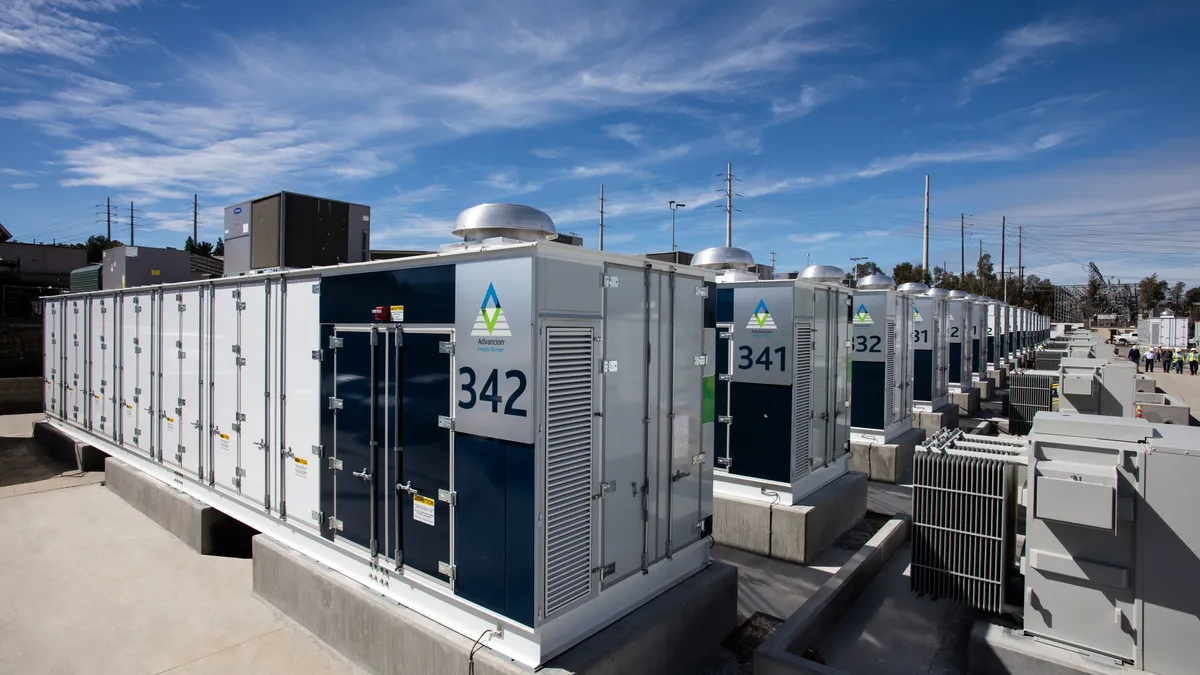Dive Brief:
-
California utility regulators are preparing to order changes to distributed energy storage plans proposed by the state's three big utilities, directing them to run open solicitations that pit utility-owned projects against independent developers.
-
A proposed decision issued this week by an Administrative Law Judge (ALJ) in the state rejects the utility-owned front-of-the-meter storage proposals filed in response to a 500 MW storage mandate in AB 2868. Instead, utilities would issue requests for offers (RFOs) for the facilities "without any bias towards any ownership model."
-
The proposed decision from ALJ Brian Stevens is not a final order, but California regulators routinely adopt ALJ findings with minimal or no changes. Utilities say they are still reviewing the proposed order, which could be considered by the California Public Utilities Commission at its March 28 meeting.
Dive Insight:
The proposed decision from ALJ Stevens illustrates increasing scrutiny on utility proposals to own emerging distribution grid technologies like energy storage, microgrids, vehicle chargers and more.
In this case, California's three large investor-owned utilities proposed projects to meet AB 2868, a 2016 law that directed the procurement of up to 500 MW of distributed storage split among them.
The proposals are multi-faceted, but each contain an opportunity for utility-owned storage facilities in front of customer meters. San Diego Gas & Electric (SDG&E), for instance, proposed seven utility-owned microgrids across its service area to enhance resilience and provide local resource adequacy.
Southern California Edison (SCE), meanwhile, proposed to run an RFP for 40 MW of utility-owned energy storage facilities on its distribution system, while Pacific Gas and Electric (PG&E) proposed a framework for storage investments, but "did not propose specific site locations, technologies, nor cost estimates for any front of the meter investments."
Despite the vagueness of some of the utility proposals, ALJ Stevens drew a line in the sand with his order, unequivocally directing utilities to allow independent developers to compete with projects utilities own.
"When procuring energy storage systems through competitive RFOs, the utilities shall consider all forms of resource ownership (utility-owned, third party owned, customer-owned, joint ownership)," Stevens wrote in an appendix to the order. "The RFO allow bid participation and [can] be evaluated without any bias towards any ownership model."
Requiring utilities to compete meets AB 2868's requirement to "not unreasonably limit or impair the ability of non-utility enterprises to market and deploy energy storage systems," Stevens added.
In addition to directing changes to front-of-meter applications, Stevens also proposed approving a PG&E program for 5 MW of behind-the-meter thermal storage using smart electric water heaters and smart control devices.
"This load shift program will encourage participants to reduce or eliminate hot water heater load during peak evening hours, effectively storing energy and using it to provide hot water when there is increased congestion on the grid," he wrote, proposing approval of more than $6 million in cost recovery for the program.
SCE and SDG&E proposed rebate programs for low-income customers to deploy solar-plus-storage facilities at their homes, but Stevens wrote those proposals were too similar to California’s Self Generation Incentive Program (SGIP), a separate initiative for behind-the-meter storage.
Implementing programs so similar to one another will "pose an unreasonable administrative burden" on both the utilities and CPUC, Stevens wrote. SCE and SDG&E were not authorized for any cost recovery in the proposed decision.
In an email to Utility Dive, an SDG&E spokesperson said the company "remains committed to integrating energy storage in the power grid to maximize renewable energy and enhance the resiliency of our community."
An SCE spokesperson said company officials are still reviewing the decision and will not have a full response until next week. PG&E did not respond to a request for comment.













